How to Maintain a Hot Tub:
To maintain a hot tub, test the water often, balance chemicals, and clean the filter weekly. Drain and refill every few months to prevent buildup. Wipe the shell and cover to stop dirt and mold. Regular care keeps water safe, extends equipment life, and makes your spa easier and more affordable to enjoy year-round.
If you want a simple routine that keeps your hot tub clean and stress-free, follow this checklist.
Daily
• Check sanitizer
• Make sure water level covers the jets
• Scoop out leaves or foam
• Open the cover for a minute to let gases escape
Weekly
• Test pH and alkalinity
• Rinse the filter
• Add a shock treatment
• Wipe the waterline
Monthly
• Deep clean the filter
• Clean the hot tub cover
• Check for weird smells or cloudy water
Every 3 to 4 months
• Drain
• Purge the lines
• Refill
• Rebalance water
Check our guide about Hot Tub Water Maintenance full guide.
- How to Maintain a Hot Tub (Step-by-Step)
- Hot Tub (Spa) Water Chemistry Cheat Sheet
- Seasonal Maintenance Checklists
- How to Winterize a Hot Tub (For Cold Climates)
- Troubleshooting Common Hot Tub Water Problems
- Essential Equipment for Maintaining
- Cost to Maintain a Hot Tub Each Month
- Safety Rules Every Owner Should Follow
- Line Purge Before Draining
- Biofilm: What It Is and How to Remove It
- What's The Best Temperature For Kid-Friendly?
- What is the pH Balance in a Hot Tub or Spa?
- The Right Way to Maintaining Your Spa Filters
- How to Prevent Hot Tub Foam
- Energy-Saving Tips to Lower Your Hot Tub Costs
- How Long Should a Hot Tub Run Each Day?
- What to Do After Heavy Use (Parties, Kids, Guests)
- FAQs
How to Maintain a Hot Tub (Step-by-Step)
Keeping a hot tub in good shape doesn’t take long, but you do need a simple routine. These steps cover everything from daily care to drain-and-refill cycles so your water stays clean and your equipment lasts longer.
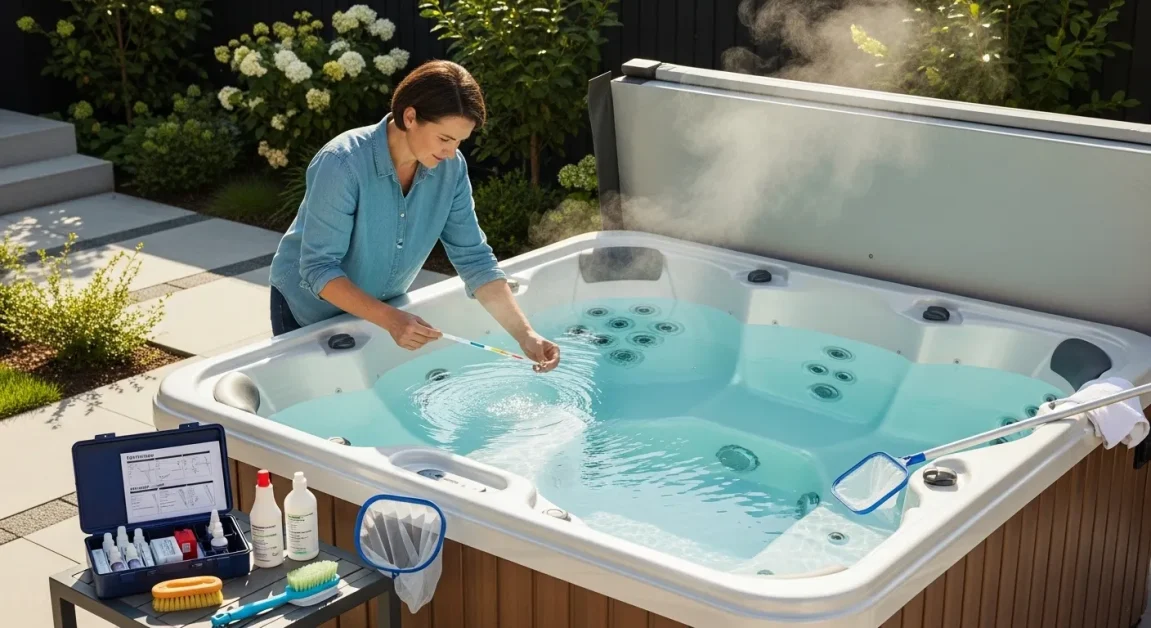
1. Check sanitizer and water level daily
Look at the water level and make sure it’s sitting above the jets. Test sanitizer levels (chlorine or bromine) and top up if the number looks low. Scoop out leaves, bugs, or foam if anything is floating on the surface.
2. Test pH and alkalinity weekly
A quick strip test once a week keeps your water balanced.
Aim for:
• pH: 7.2 to 7.8
• alkalinity: 80 to 120 ppm
If the pH is off, the water can feel irritating and your sanitizer won’t work as well.
3. Rinse the hot tub filter weekly
Pull the filter out and rinse it under clean water. This helps your jets stay strong and reduces strain on the pump. If the water ever looks cloudy, rinse the filter again.
4. Add a shock treatment weekly
A shock dose clears out lotions, sweat, oils, and anything sanitizer can’t handle on its own. Run the jets for ten to fifteen minutes with the cover open after adding it.
5. Deep clean the filter once a month
Use a filter cleaner soak to break down oils stuck inside the pleats. Let the filter dry completely before putting it back, or rotate between two filters so one is always ready.
6. Clean the hot tub cover monthly
Wipe the cover top and bottom with a mild cleaner, then use a protectant to block sun damage, mildew, and cracking. A clean cover also keeps heat in and lowers your energy bill.
7. Drain, purge, and refill every three to four months
Even if the water looks clear, contaminants build up in the pipes. Add a line purge, run the jets, drain the tub, rinse everything, refill, and balance your water again.
8. Seasonal checks
Cold weather and hot weather affect water differently.
• In winter, keep the cover sealed tight and check water levels more often.
• In summer, pH shifts faster, so test more frequently.
Hot Tub (Spa) Water Chemistry Cheat Sheet
Takeaway
Keeping water balanced protects your skin and your equipment. These are the numbers most manufacturers recommend.
Ideal water levels
• pH: 7.2 to 7.8
• Alkalinity: 80 to 120 ppm
• Chlorine: 1 to 3 ppm
• Bromine: 3 to 5 ppm
• Calcium hardness: 150 to 250 ppm
Why these numbers matter
• Low pH stings your eyes and eats metal parts
• High pH causes cloudy water and weak sanitizer
• Low alkalinity makes pH bounce all over the place
• Low calcium can damage the heater
• High calcium causes white flakes and scale
If your water looks cloudy, your pH or sanitizer is almost always the reason.
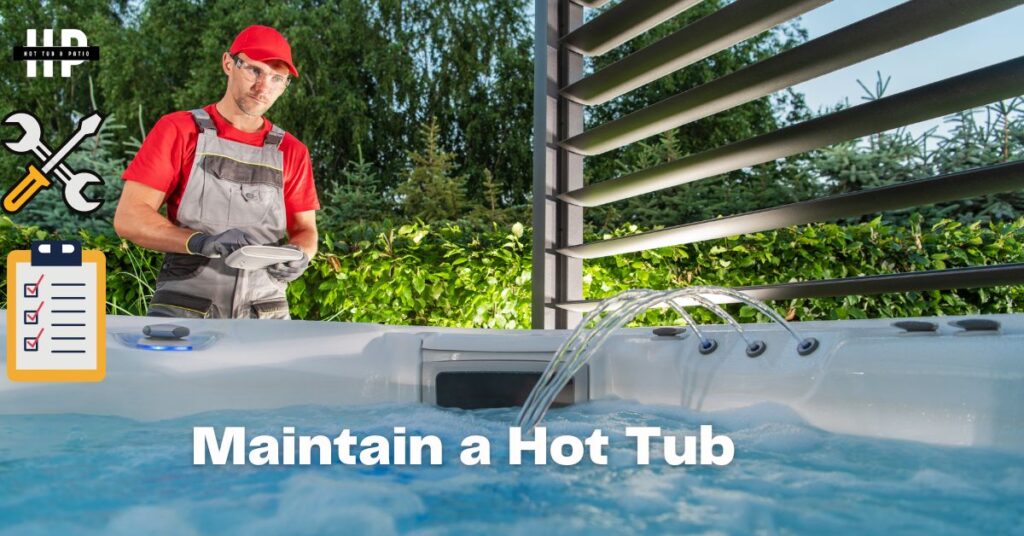
Seasonal Maintenance Checklists
Winter care
• Keep water topped up
• Don’t shut off the heater
• Check for ice around equipment
• Make sure the cover seals tight
Summer care
• Lower temperature to 97–99°F
• Watch pH, heat speeds up chemical changes
• Adjust run times so the tub doesn’t overheat
Before vacations
• Shock the tub
• Top up sanitizer
• Turn temperature down a few degrees
• Lock the cover
Seasonal steps keep your tub running smoothly no matter the weather.
How to Winterize a Hot Tub (For Cold Climates)
If you aren’t using your hot tub during freezing weather, you need to winterize it so the pipes don’t crack.
Steps
- Turn off power at the breaker
- Drain all water from the tub
- Remove filter and drain pump housing
- Use a wet-dry vacuum to blow out lines
- Add RV antifreeze to plumbing lines
- Wipe the shell dry
- Leave the cover locked in place
If temps hit freezing, even a little leftover water can expand and break fittings. Winterizing protects your investment. Check our guide Winterizing Your Hot Tub.
How to De-Winterize in Spring
Bringing your spa back online only takes a few steps. Your spa should be ready to heat within a few hours.
What to do
- Rinse out antifreeze
- Reinstall filters
- Refill through the filter compartment
- Power the tub back on
- Balance alkalinity
- Adjust pH
- Add sanitizer
- Run jets for 20 minutes
Troubleshooting Common Hot Tub Water Problems
Most water issues fall into four buckets: cloudy, foamy, smelly, or green. Here’s how to handle each one. A hot tub should never smell or look weird. If it does, the chemistry slipped somewhere.
Cloudy water
Common causes
• Low sanitizer
• Dirty filters
• High pH
Fix
• Shock the tub
• Rinse the filter
• Rebalance pH
Foamy water
Common causes
• Soap, lotion, or detergent from swimsuits
Fix
• Add anti-foam
• Rinse suits in plain water
• Drain sooner if the foam keeps coming back
Smelly water
Common causes
• Not enough sanitizer
• Biofilm growing in the plumbing
Fix
• Shock heavily
• If smell remains, purge lines with a biofilm cleaner
• Drain and refill
Green water
Common causes
• Algae
• Low sanitizer
Fix
• Add shock
• Brush surfaces
• Fix pH
• Clean filter
• If green after 24 hours, drain
Essential Equipment for Maintaining
You’ll require essential tools and supplies to effectively maintain your hot tub. These include a test strip or digital tester to monitor pH, total alkalinity, and sanitizer levels, a cover cleaner and protectant to preserve the body, a filter cleaner to eliminate debris, a shock treatment to kill bacteria, and a hot tub cleaner for removing build-up and scum from surfaces.
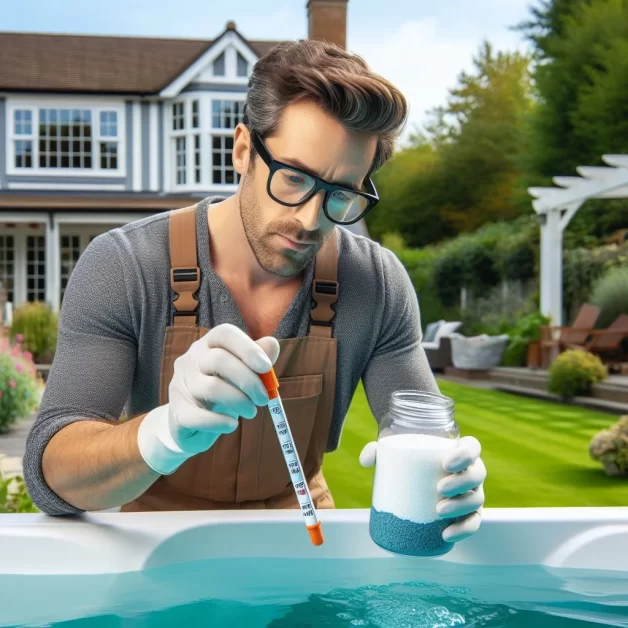
For more about How to get rid of hot tub bacteria.
Cost to Maintain a Hot Tub Each Month
Most people spend $25 to $50 per month to keep their tub healthy.
| Cost | Typical Range | Notes |
|---|---|---|
| Chemicals | $12 to $25 monthly | varies by system |
| Electricity | $10 to $30 monthly | insulated covers help |
| Filter replacement | $40 to $60 yearly | replace every 12 to 18 months |
| Purge chemicals | $10 every few months | used before draining |
Safety Rules Every Owner Should Follow
A few small habits prevent most injuries and equipment damage. These simple habits protect everyone using the spa.
• Never mix chemicals
• Keep water below 104°F
• Add shock with the cover open
• Don’t use household cleaners inside the tub
• Don’t soak filters with soap
• Never leave the water level below the jets
• Keep kids out unless an adult is supervising
• Turn off power before draining

Line Purge Before Draining
This is one step most new owners skip, and it’s the difference between clean plumbing and hidden biofilm. This gets rid of the slimy buildup inside the pipes, which is the biggest source of smelly water.
Here’s how to do it:
- Add a plumbing purge product
- Run the jets for 15 to 20 minutes
- Let it sit for a few hours
- Drain the tub
- Rinse the shell
- Refill with fresh water
Biofilm: What It Is and How to Remove It
Biofilm is the slimy layer that hides inside plumbing lines. It’s the number one reason a clean-looking tub still smells bad.
How to spot it
• Hot tub smells even after shocking
• Water feels slimy
• pH drops fast
• Rashes after soaking
• Weird discoloration around jets
How to remove it
- Add a plumbing purge formula
- Run jets for 15 to 20 minutes
- Let it sit several hours
- Drain the tub
- Rinse everything
- Refill with fresh water
Removing biofilm instantly improves water clarity and reduces chemical demand.
What’s The Best Temperature For Kid-Friendly?
When it comes to finding the best hot tub temperature for kids, there isn’t one definitive answer. That being said, there are a few things parents should keep in mind when it comes to making sure their children are safe and comfortable in a hot tub.
Generally speaking, hot tubs should be kept between 90 and 104 degrees Fahrenheit. This is the range that is considered safe for both adults and children. However, if you have smaller children, it might be a good idea to keep the temperature closer to 90 degrees so they don’t get too warm.
Another thing to consider is how long your child will be in the hot tub. Small children shouldn’t stay in for more than 10-15 minutes at a time, while older children can stay in for up to 30 minutes.
What is the pH Balance in a Hot Tub or Spa?
Most people don’t know the pH balance of their hot tub. It can be different in different areas, even though your water may look perfectly clear and beautiful after a spa treatment with chemicals, it may still be off-balance.
The ideal range for pH levels is between 7.4 and 7.6, but the pH levels in your area may warrant a slightly different range. Take a water sample to a professional who can test it for you to re-balance the spa if needed and see how it goes after that.
pH Balance of Spas is Important:
For proper use, the spa needs ideal water treatment for your specific location. Hot tubs need a pH balance of 7.4 to maintain healthy chlorine residual and at least 1 to 3 ppm calcium hardness. This will ensure that the water does not turn green from algae growth, which is caused by unstable chemicals in it. This is the Hot Tub Water Chemistry:
- Chlorine: 1.0-2.0 ppm
- Bromine: 2.0-3.0 ppm
- Total Alkalinity: 80-110 ppm
- pH Level: 7.4-8.6
- Calcium Hardlines: 150-240 ppm

NOTE
Test chemicals or oils before use to confirm effectiveness. Prioritize checking pH balance before adding any chemicals to prevent contamination. You guarantee a pleasurable and healthy hot tub experience by consistently managing chemical levels and pH balance. Contact us for water testing or treatment assistance; we’re here to meet all your hot tub needs.
The Right Way to Maintaining Your Spa Filters
You should change your hot tub filters at least once per year, even if they don’t look dirty. filters catch a lot of things that we don’t see floating in the water and we want to keep them as clean as possible.
If you use an Ozonator, it will be long before you need to change the filters because it also sanitizes the water. For cartridge-type filter systems, inspect them monthly for tears or rips that can let particles slip through.
1. Clean the Filter Pads
The most common filter is a foam pad (sometimes called bio media) which needs to be cleaned periodically to maintain maximum performance. Use a garden hose with an adjustable spray nozzle to spray out the filter repeatedly until the water runs clear.
2. Don’t Forget about the Spa Skimmer
Some spas have open skimmers that you can just take apart and clean out, while some others have grates on top of them that you can’t get into very easily without taking apart the whole unit. If your skimmer is open, just pull out the foam piece inside and rinse it off with a garden hose while running water through the rest of it.
3. Replace the Filter Cartridge
If the foam filter is extremely dirty, you may have to replace it. Remove your old one and put in a new one until you are able to clean all the cells. Usually, if the cells are very clogged with sand or dirt inside, it’s not worth trying to clean them – just replace them! If you want to clean the cells, soak in some dish soap for a while and scrub with an old toothbrush.
4. How Often Should You Change Your Hot Tub Filter?
It’s important to replace hot tub filter cartridges regularly since they become clogged with dirt and oil that can be circulated into the water system. At a minimum, they need to be replaced every 3-4 months. If you use them more than the average person (have lots of parties, etc) – change them more often!
5. How Often Should You Change Your Spa Water?
Well, how dirty is your spa getting between treatments?! The water in your spa should be changed at least once per year. For most hot tubs, changing the water is probably the easiest thing to do when it comes time! Just siphon out all of the water in your tub and replace it with fresh, treated water.
6. Draining and Refilling the Hot Tub
The following is a guide for maintaining it which includes buying tips and information about how to drain and refill the hot tub. It’s important to realize that bacteria can survive in your spa despite the sanitizer you add due to a sticky substance that forms plumbing called biofilm.
How to Prevent Hot Tub Foam
Foam usually comes from oils, lotions, detergents, or low sanitizer. A little foam is normal during jets, but big white bubbles are a sign something’s off.
How to stop foam
• Rinse swimsuits in plain water, never detergent
• Shower before entering the tub
• Keep sanitizer steady
• Shock after heavy use
• Deep clean filters monthly
• Drain earlier if foam returns quickly
Energy-Saving Tips to Lower Your Hot Tub Costs
Most owners save $10–$20 monthly just by improving insulation and cleaning filters. A few easy changes can cut your energy bill without affecting water quality.
Try these habits
• Keep the cover closed tight
• Lower temperature when not using it
• Clean or replace worn-out cover seals
• Rinse filters weekly so the pump doesn’t work too hard
• Use economy mode if your model has it
• Keep water chemistry balanced to reduce heater strain
How Long Should a Hot Tub Run Each Day?
If your water gets cloudy, increase cycle time for a few days. Most tubs run 8 to 12 hours daily through built-in cycles.
Circulation basics
• A well-balanced tub needs about one full turnover every hour
• Modern spas handle this automatically
• Running it longer improves water clarity
• During winter, circulation helps prevent heat loss
What to Do After Heavy Use (Parties, Kids, Guests)
Takeaway
More people in the water means more lotion, sweat, sunscreen, and bacteria. Shock treatment is non-negotiable.
Right after guests leave
• Add shock
• Run jets for 10 minutes
The next morning
• Test pH
• Check sanitizer
• Rinse the filter
If the water still looks off, add another shock dose or plan a partial drain.
🔍 Want more info? Head over to Hot Tub Patio 🛁 or check our Guides 📖 for extra reading!
Conclusion:
In ending, maintaining a hot tub is essential to extend its lifetime and ensure its safety. Regularly checked hot tub pH levels, clean filters, and balanced chemicals will go a long way in keeping your hot tub running smoothly. Further, remember to empty and scrub the interior after every few weeks of use, as well as cover it when not being used to protect it from the elements.

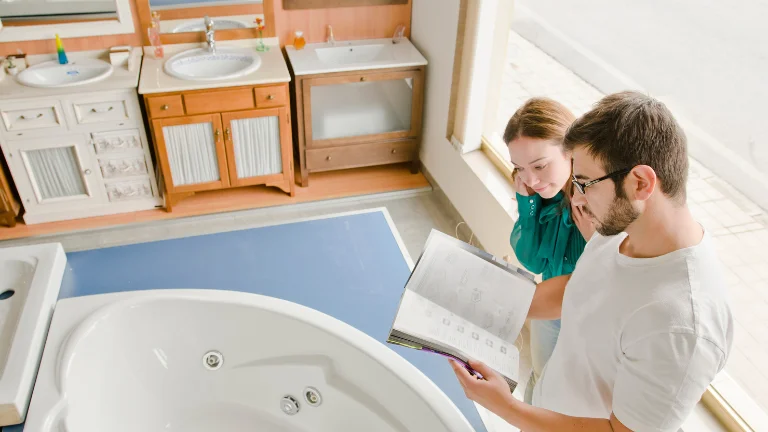





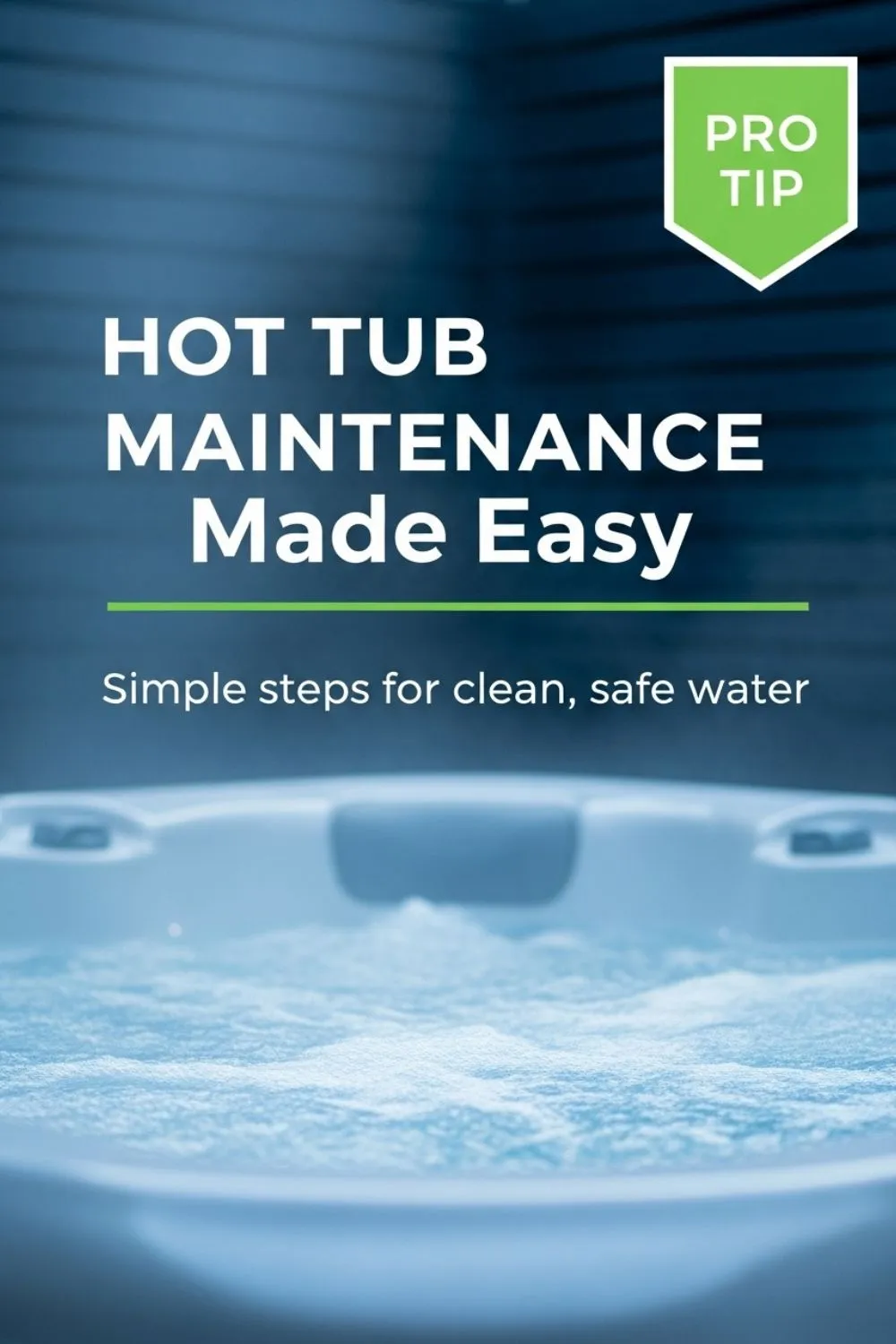
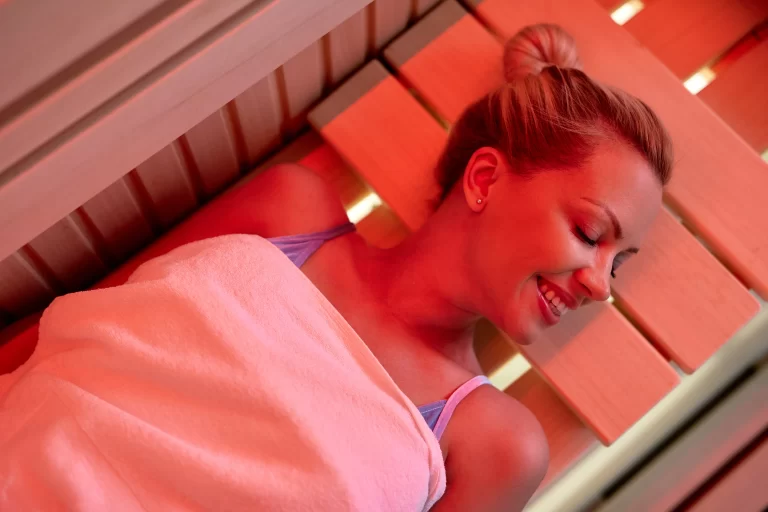

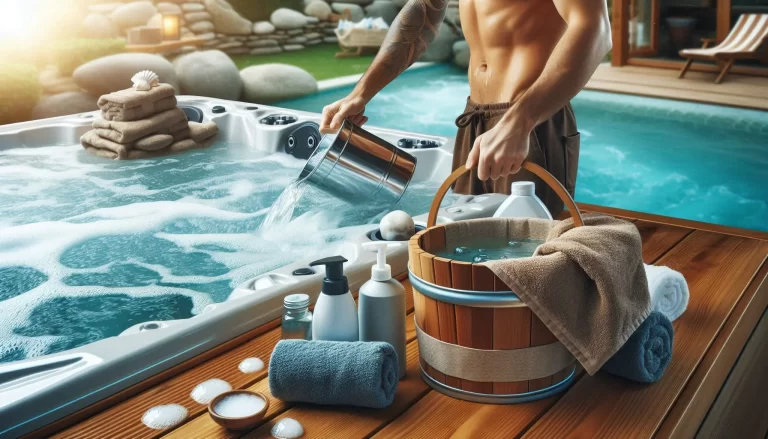


21 Comments